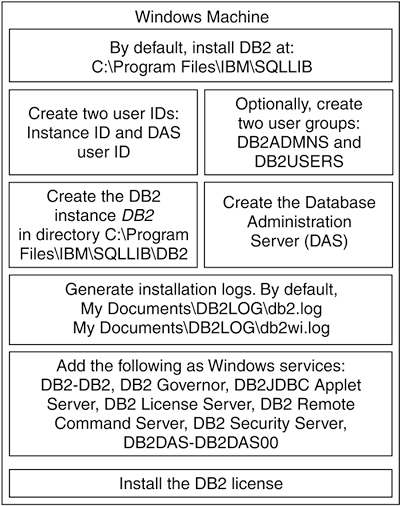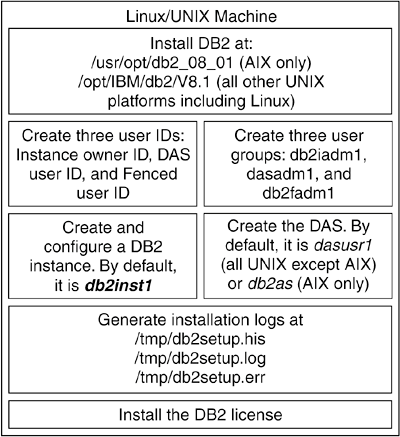Section 3.1. DB2 Installation: The Big Picture
3.1. DB2 Installation: The Big PictureTable 3.1 lists the two methods for installing DB2 on Windows and the four methods for installing DB2 on Linux/UNIX.
The DB2 Setup Wizard provides an easy-to-use graphical interface for installing DB2. In addition to creating a DB2 instance and required user IDs, it also sets up some initial configuration parameters. It guides you through the installation tasks listed in Figures 3.1 and 3.2. After the installation is completed, DB2 is ready for use. We recommend that you use this installation method. Figure 3.1. The big picture: DB2 installation on Windows
Figure 3.2. The big picture: DB2 installation on Linux/UNIX
Imagine you have to install DB2 on thousands of machines. Although the DB2 Setup Wizard is easy to use, it is an interactive tool, which means you have to physically sit in front of the screen and input values when the wizard prompts you. As you can imagine, if you have to install DB2 on many machines, this process is extremely time-consuming. To avoid this, DB2 offers the Silent install method. The key to this installation method is the response file, a text file that contains setup and configuration values. You pass this file to the DB2 setup program as input, and then the setup program installs DB2 according to the values specified in the response file, unattended. The db2_install script (only available on Linux/UNIX platforms) uses the operating system's native installation utility to install DB2. The db2_install script prompts for a DB2 product keyword and then installs all components for the DB2 product you specify. You cannot select or deselect components or specify the language to be used. The db2_install script does not perform user and group creation, instance creation, or configuration; it simply installs the DB2 components onto your system. You might prefer this method of installation if you want to customize the instances and their configurations yourself. Installing DB2 using your operating system's native installation tools provides the greatest control over the installation process, but it is also more difficult than the other installation methods. This method is only available on Linux and UNIX platforms. When installing a particular DB2 product, you have to ensure that the required components are installed and that component dependencies are maintained. This requires advanced knowledge of both DB2 and your operating environment. You must manually perform user and group creation, instance creation, and configuration. Figures 3.1 and 3.2 give you an overview of the various installation methods on the Windows and Linux/UNIX platforms respectively. The figures also list the items that the DB2 Setup Wizard creates. We recommend using the DB2 Setup Wizard for all platforms, and we focus on that method in this chapter. |
EAN: 2147483647
Pages: 313

